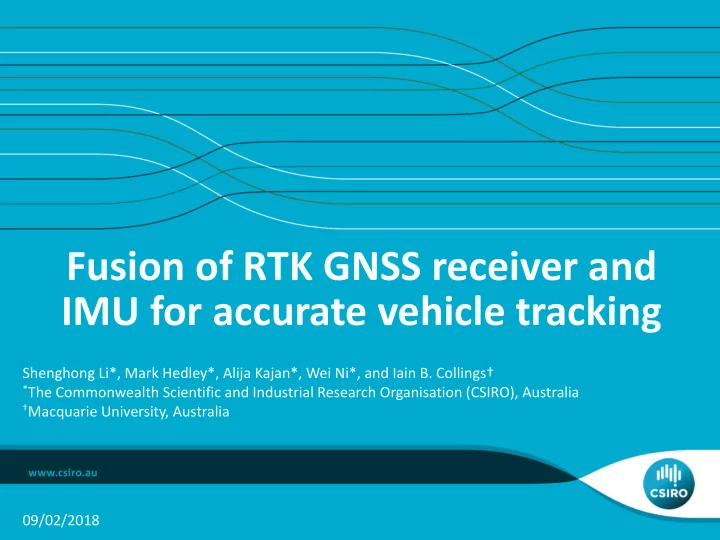

Fusion of RTK GNSS receiver and IMU for accurate vehicle tracking Shenghong Li*, Mark Hedley*, Alija Kajan*, Wei Ni*, and Iain B. Collings† * The Commonwealth Scientific and Industrial Research Organisation (CSIRO), Australia † Macquarie University, Australia 09/02/2018
Outline Backgrounds RTK ‐ GPS IMU ‐ based Sensor Fusion Scenario: unsynchronized GPS and IMU measurements Proposed Approach Joint trajectory and clock offset estimation Simplified approach: bisection search over clock offset with conventional Bayesian smoothing ‐ based tracking Experimental Results Conclusion
Background – RTK GPS Rover Base Receiver Carrier phase tracking Station Centimetre ‐ level accuracy in fixed mode Key performance indicator: fixing ratio Data Link Accuracy significantly reduced in floating mode Blue dots: RTK fixed Red dots: RTK float
Background – IMU ‐ based Sensor Fusion Sensor Fusion in Wireless Positioning Systems IMU measurements complementary to wireless range measurements Advantages Higher Accuracy & Reliability Information on attitude Provide position information during GPS outage (e.g., receiver in tunnels)
Scenario …… ……
Lack of clock synchronization between GPS receiver and IMU GPS clock …… IMU clock …… Δ� � ��� � � ��� � Δ� (IMU started late)
Impact of clock offset between GPS receiver and IMU Δ� =0.5s 50Km/h 12:00:00.0 @GPS 12:00:00.5 @GPS 11:59:59.5 @IMU 12:00:00.0 @IMU At IMU time 12:00, using the GPS measured at GPS time 12:00, which in fact is the 7m position measured 0.5s ago.
Tracking result without considering the clock offset GPS GPS + IMU (EKF)
Tracking result without considering the clock offset GPS GPS + IMU (EKF)
Proposed approach – Estimate the clock offset in the fusion algorithm Problem formulation (Bayesian) � � � � � � ��� , Δ� � � , � � ��� , � � ��� � � � � � � � � � Δ� � � � � � ��� � � �� � � � � � ��� ��� Extremely hard to solve (linearization in EKF, Monto Carlo method in PF) Reason: Δ� controls � � , the association between GPS and IMU measurements.
The role of …… GPS clock Δ� =0 …… IMU clock …… GPS clock Δ� � 0 …… IMU clock
Proposed approach For a given Δ� Work out the association between GPS and IMU measurements Apply conventional sensor fusion algorithm (Bayesian smooth) � � � Δ�: � � , � � ��� , � � ��� ⇒ � � ��� � If Δ� is correct, the estimated trajectory � � ��� should be consistent with � the GPS measurements � � ��� Search over Δ� , find the clock offset that results in the highest consistency between the estimated trajectory and the GPS measurements (minimum RMSE) Since the dimension of Δ� is one, the search can be done efficiently using bisection method
Experiments GPS and IMU are independently packed modules – no means to drive both devices with one clock “Manual synchronization” attempted (press the start buttons for both devices at the same time)
Experiments “Manually Synchronized” to 0.4 s! Δ� Relationship between the RMSE and clock offset
Results – Example 1 ‐ No clock offset correction GPS GPS + IMU (EKF)
Results – Example 1 – With clock offset correction GPS GPS + IMU (EKF)
Results – Example 2 ‐ No clock offset correction GPS GPS + IMU (EKF)
Results – Example 2 – With clock offset correction GPS GPS + IMU (EKF)
Conclusion Clock synchronization between GPS and IMU critical for vehicle tracking Arrives when developing sensor fusion systems with independently ‐ packed GPS receivers and IMUs Include clock offset as a nuisance parameter to be estimated along with the trajectory Simplified to bisection search with conventional Bayesian smoothing ‐ based tracking With the clock offset worked out, the data can be corrected and used for scientific research or engineering test
Recommend
More recommend